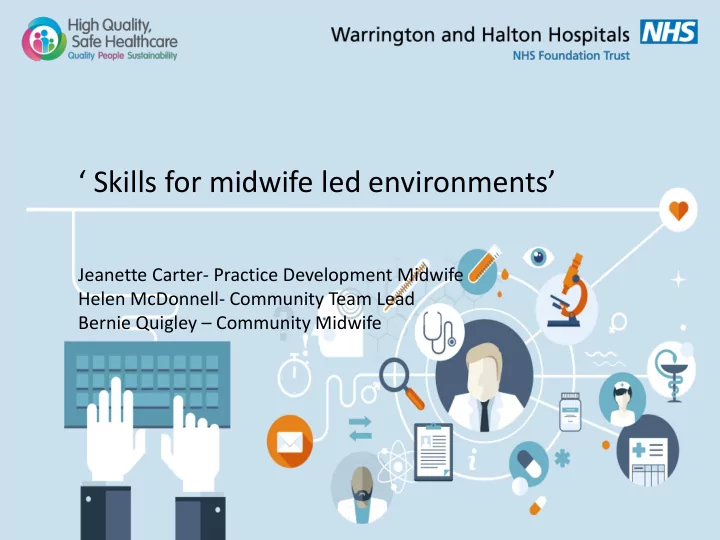

‘ Skills for midwife led environments’ Jeanette Carter- Practice Development Midwife Helen McDonnell- Community Team Lead Bernie Quigley – Community Midwife
The Background • The annual homebirth rate at WHFT is 0.34%. • The community midwives rely on homebirth for their intrapartum exposure. • Need to maintain skills and confidence in order to promote and support homebirth. • Mandatory training does not meet the bespoke needs of the Community Midwife.
Ultimate Aim….. To produce a tailor made study day that met the needs of the community team.
The Planning • In 2016 four core trainers attended a bespoke 2 day RCM accredited residential training course. The ASAP course (Appropriate Skills for Appropriate Places). • The core team included the PDM, Consultant Midwife, Community Team Lead and Community Midwife. • The course programme focused on promoting the role of midwives in the community and their ability to provide up to date evidenced based care. • The overall focus was on the promotion of normality, risk assessment and dealing with Obstetric Emergencies in the community
Outcomes from attending the course • Networking opportunity- midwives from all over the UK. • Team building opportunity. • Opportunity to reflect on how we could replicate this at Warrington. • ‘Real life’ opportunity to practice emergencies in a realistic environment. • Following completion the passion to develop our own local training courses.
What next ? • Motivated and raring to go ! • Questionnaire to determine the community midwives needs. • Reviewed procedures, equipment and documentation for homebirth. We needed to ensure the ‘tools’ needed were readily available. • Developed a bespoke training day.
What did the midwives want ? Training • Management of obstetric emergencies in an a homebirth environment. • Separate training from general mandatory training sessions. • Opportunity to train with their peers. Homebirth equipment • To formalise/standardise the paperwork completed by the midwife at the 36/40 home visit appointment. • To streamline the equipment delivered to the woman at home prior to the homebirth. • To review the emergency equipment carried by the community midwives to a homebirth.
Training • Where could this take place ? We wanted to replicate the home from home environment we had experienced at Powys. • Someone's home, hotel/B&B, the residence at Warrington? • We decided to utilise the OT Flat with the support of the Occupational Therapy Team. This was on-site, accessible, had a bathroom, stairs, bedroom/lounge and kitchen, ideal for simulation and free! • The course was planned to be delivered in the evening, as the OT Flat was used for patient assessments in the day time. • Four days were planned to ensure small groups of midwives attended (5-6).
The Programme Promoting Normality – Homebirth scenarios Record Keeping Risk assessment- Booking, 36 weeks and Intrapartum. Birth Place study findings- individual statistics for midwives Training updates- Waterbirth, Perineal suturing, Physiological third stage. Launch of new paperwork, equipment, safe transfer.
‘Real time’ scenarios. • ‘ Live’ • Simulated persons. • Core emergency drills- (breech, shoulder dystocia, cord prolapse, haemorrhage). • Variety of environments- birth pool, bathroom, lounge, floor, staircase. • Waterbirth scenarios • De-brief. • Safe transfer.
What did the midwives think ? Realistic/relevant to our Loved group exercises working environment very realistic (enjoyed the opportunity for peer review) These drills within the Very relevant to our job in practice setting. It really comparison to other bridges the gap between training days. theory and practice Risk assessments for home Scenarios especially delivery and statistics to designed for community give women. Loved it ! Feel more confident to Relaxed atmosphere to deliver care at home enable discussion confinement
Further developments • New Homebirth bags in liaison with the resuscitation department. • Formalised ‘dry kit’. • Formalised homebirth risk assessment and associated paperwork.
Monitoring impact on practice • Audit homebirth bookings • Audit homebirth rate. • Review transfer rates • Review homebirth outcomes • Audit compliance re: risk assessment. • Staff survey/questionnaire. • Evaluate ‘friends and family’.
What we hope to see ! Risk assessment Equipment changes Promoting Normality Empowerment Confidence CULTURE CHANGE!
The future • Changing model of care. • Community midwives to rotate to MLU. • Training to involve paramedic crews. • Plan additional bespoke days to incorporate community midwifery requirements.
Recommend
More recommend